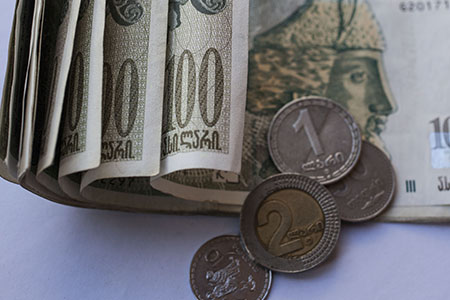IMF says Georgian Lari has “bright future”

Georgia’s national currency, the Lari, is beginning to stabilise since it began dropping in value against the US dollar about seven months ago. Meanwhile in the past three days the Lari has strengthened.
The National Bank of Georgia set a new exchange rate. From tomorrow, May 21, 1 USD will cost 2.3234 GEL. Previously the exchange rate saw 1 USD equal 2.3567 GEL.
According to the new exchange rate, the lari has also slightly gained value against the euro. From May 21, 1 EUR will cost 2.5794 GEL, while the previous rate was 2.6204 GEL.
Meanwhile, International Monetary Fund (IMF) Resident Representative in Georgia Azim Sadikov said the the national currency Lari, like Georgia, had a "bright future”.
In an exclusive interview with Georgian business online media Bpn.ge, Sadikov said in the mid-term, if the Government moved away from a dollarized economy, this would limit the effects on the fluctuation of the national currency, the Lari.
In addition, the causes and implications of the Lari depreciation against the greenback were external shocks and the recent appreciation of the US dollar, he said.
The Georgian Government must strengthen its efforts to move away from an economy that’s dependent on the US dollar, said Sadikov adding that keeping the Lari fluctuating, and possibly devalue, was the "best reaction to economic shocks”.
"This creates an opportunity for the exchange rate to shield the true economy from such pressure, but in a highly dollarized economy, like Georgia, we must recognise that devaluation creates problems for people who have loans.”
In the short term it is important to find ways to alleviate this pain - at least partially,” said Sadikov.
In the last 12 months the Lari has depreciated by 30 percent against the US dollar.
Sadikov explained the Lari had devaluated because of exchange rate developments, such as the appreciation of the US dollar and the depreciation of the Russian Ruble and Ukrainian Hryvnia. Similarly, the Euro had depreciated by 20 percent against the US dollar, while the Turkish Lira had depreciated by almost 30 percent.
Another reason of the Lari’s devaluation was external factors that had affected Georgia.
"Georgia’s export and remittances decreased significantly – by 25-30 percent. The reduction of foreign currency to the country enlarged the current account deficit and the foreign funding shortfall. All these affected the Lari,” Sadikov said.
The IMF representative noted the Georgia Government could not forecast in advance the possible devaluation of the Lari or the US dollar’s appreciation. Furthermore, it was "impossible” to know in advance about the Russia-Ukraine conflict and the global drop in oil pices.
"However the Government can develop a policy that prepares the country for the possible shocks which gives it more endurance,” Sadiko said.
Despite devaluation against the USD, trust in the Georgian national currency still exists. We have not noticed massive conversions from Lari to other currencies. The Lari still maintains its purchasing power” he said.
"Increased flexibility of the GEL will promote development of Georgia in the mid-term.”
Now, Georgia must choose which path to take: to strengthen the Lar temporarily or to grow the economy.
The Government may run the fiscal policy, while the National Bank of Georgia may tighten the monetary policy. However this could lead to a recession and depress the economy. So there is a choice between temporarily strengthening the Lari and economic growth,” Sadikov said.
"The Lari devaluation against the US dollar enables Georgia to maintain its competitive advantage because otherwise it would lose this advantage in terms of trade and tourism. Now it is important the Government should keep its policy in terms of the de-dollarization process,” Sadikov concluded.
 Tweet
Tweet  Share
Share